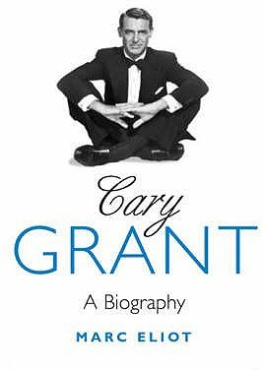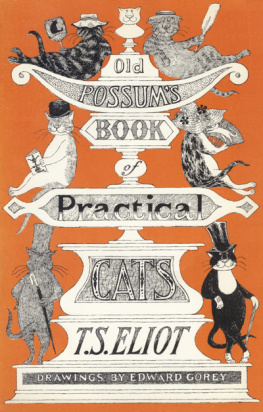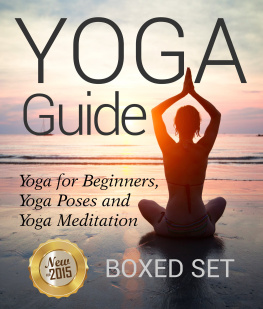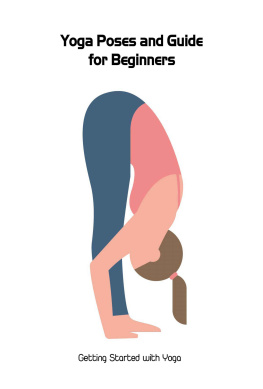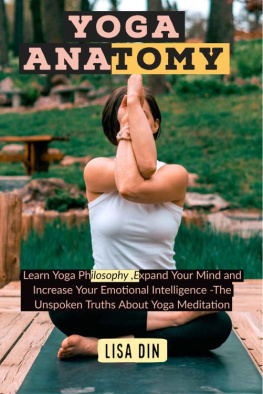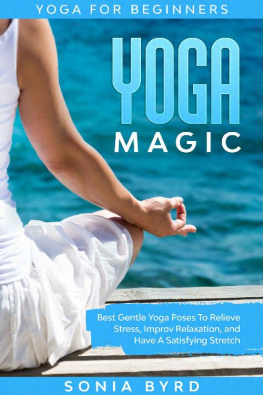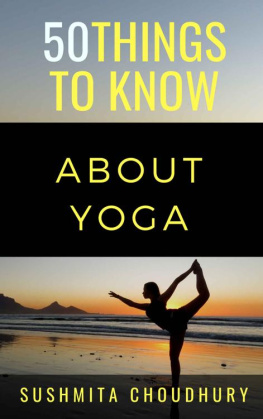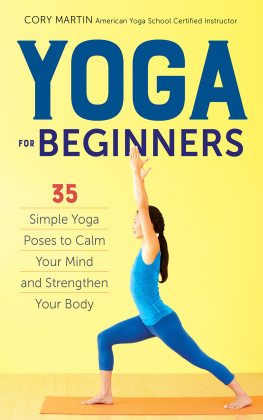Eliot - A Journey Into Yin Yoga
Here you can read online Eliot - A Journey Into Yin Yoga full text of the book (entire story) in english for free. Download pdf and epub, get meaning, cover and reviews about this ebook. City: Champaign;IL, year: 2019, publisher: Human Kinetics, Inc., genre: Religion. Description of the work, (preface) as well as reviews are available. Best literature library LitArk.com created for fans of good reading and offers a wide selection of genres:
Romance novel
Science fiction
Adventure
Detective
Science
History
Home and family
Prose
Art
Politics
Computer
Non-fiction
Religion
Business
Children
Humor
Choose a favorite category and find really read worthwhile books. Enjoy immersion in the world of imagination, feel the emotions of the characters or learn something new for yourself, make an fascinating discovery.

A Journey Into Yin Yoga: summary, description and annotation
We offer to read an annotation, description, summary or preface (depends on what the author of the book "A Journey Into Yin Yoga" wrote himself). If you haven't found the necessary information about the book — write in the comments, we will try to find it.
Eliot: author's other books
Who wrote A Journey Into Yin Yoga? Find out the surname, the name of the author of the book and a list of all author's works by series.
A Journey Into Yin Yoga — read online for free the complete book (whole text) full work
Below is the text of the book, divided by pages. System saving the place of the last page read, allows you to conveniently read the book "A Journey Into Yin Yoga" online for free, without having to search again every time where you left off. Put a bookmark, and you can go to the page where you finished reading at any time.
Font size:
Interval:
Bookmark:
A JOURNEY INTO YIN YOGA
Travis Eliot

Library of Congress Cataloging-in-Publication Data
Names: Eliot, Travis, 1977- author.
Title: A journey into yin yoga / Travis Eliot.
Description: Champaign, IL : Human Kinetics, [2019] | Includes bibliographical references. | Description based on print version record and CIP data provided by publisher; resource not viewed.
Identifiers: LCCN 2017054032 (print) | LCCN 2017051928 (ebook) | ISBN 9781492557234 (ebook) | ISBN 9781492557227 (print)
Subjects: LCSH: Yin yoga.
Classification: LCC RA781.73 (print) | LCC RA781.73 .E45 2019 (ebook) | DDC 613.7/046--dc23
LC record available at https://lccn.loc.gov/2017054032
ISBN: 978-1-4925-5722-7 (print)
Copyright 2019 by Travis Eliot
All rights reserved. Except for use in a review, the reproduction or utilization of this work in any form or by any electronic, mechanical, or other means, now known or hereafter invented, including xerography, photocopying, and recording, and in any information storage and retrieval system, is forbidden without the written permission of the publisher.
This publication is written and published to provide accurate and authoritative information relevant to the subject matter presented. It is published and sold with the understanding that the author and publisher are not engaged in rendering legal, medical, or other professional services by reason of their authorship or publication of this work. If medical or other expert assistance is required, the services of a competent professional person should be sought.
The web addresses cited in this text were current as of March 2018, unless otherwise noted.
Senior Acquisitions Editor: Michelle Maloney; Developmental Editor: Laura Pulliam; Managing Editor: Ann C. Gindes; Copyeditor: Annette Pierce; Permissions Manager: Martha Gullo; Graphic Designer: Whitney Milburn; Cover Designer: Keri Evans; Cover Design Associate: Susan Rothermel Allen; Photographs (cover and interior): Patricia Pena, Human Kinetics, unless otherwise noted; Photo Production Coordinator: Amy M. Rose; Photo Production Manager: Jason Allen; Senior Art Manager: Kelly Hendren; Illustrations: Human Kinetics, unless otherwise noted; Printer: Versa Press
We thank Astroetic Studios in Los Angeles, California, for assistance in providing the location for the photo shoot for this book.
Human Kinetics books are available at special discounts for bulk purchase. Special editions or book excerpts can also be created to specification. For details, contact the Special Sales Manager at Human Kinetics.
Printed in the United States of America10987654321
The paper in this book is certified under a sustainable forestry program.
Human Kinetics
P.O. Box 5076
Champaign, IL 61825-5076
Website: www.HumanKinetics.com
In the United States, email info@hkusa.com or call 800-747-4457.
In Canada, email info@hkcanada.com.
In the United Kingdom/Europe, email hk@hkeurope.com.
For information about Human Kinetics coverage in other areas of the world,
please visit our website: www.HumanKinetics.com
E7122
For all my teachers, who have inspired me along the path of yoga and for all students seeking a life of wisdom, balance, and purpose.
CONTENTS
POSE FINDER
FOREWORD
Yin yoga has exploded in popularityand for good reason. We would all be well served by adding yin practice to our routines, and Travis book is an excellent guide for doing just that. Grounded in his personal experience of discovering the potential for yin yoga to heal and strengthen, Travis expertly leads you on a path to this transformational practice.
I first met Travis at a teacher training on yoga medicine, myofascial release, and Chinese medicine I led in Spain, where we were able to connect and share a common interest in the powerful physical effects of these practices. There are many elements that make yin practice so powerful, and the effects on the fascia are one important part. Fascia is a type of connective tissue that creates a three-dimensional scaffolding, interconnected from head to toe to support and protect. Working with the fascia is an important facet of physical healing, regardless of whether that is done by another person (as in massage and other forms of bodywork) or by yourself (as with self-myofascial release methods and yin yoga). Maintaining movement in the fascia is important so that tissues can easily glide past each other and maintain proper hydration, neurologic feedback, pliability, and elasticity.
Tight and restricted fascia can become a source of tension to the rest of the body, producing pain or restricting movementan all-too-common scenario in our modern times. Although hatha yoga practices can slowly retrain the soft tissue over time, working directly on the fascia with yin yoga can dramatically speed up soft tissue changes and assist in maintaining pliability and strength of the fascia and other connective tissues. Yin yoga is an excellent method of stimulating self-healing, and I use it with a variety of patients, including professional athletes, caregivers, doctors, mothers, and office workers. As a yoga teacher and as a health care provider, I believe this type of yoga practice is still an extremely overlooked aspect of tissue health and overall wellness.
Another aspect that is important to acknowledge is yin yogas effect on the bodys vital energies. Subtle energy, or chi, is often referred to as our life force or energy on the verge of materializing . A yin practice allows us to be introspective as a way of better adjusting to the fluctuations of this energy in the body. In Chinese medicine, health is depicted as the delicate balance of yin and yang. In this book, Travis simple explanations of these concepts help the reader understand the importance of balancing these opposing forces of yin and yang in our lives, helping the reader to more easily identify how to amplify health and wellness on a daily basis.
We spend so much of our day-to-day life motored by the adrenaline-fueled sympathetic nervous system (SNS, the fight or flight system) that our parasympathetic nervous system (PNS, the rest and digest system) can weaken and lose its ability to adapt and respond. The more active yoga practices, like vinyasa and ashtanga, feed the SNS-controlled parts of the body, and yin yoga feeds the PNS-controlled parts. If were only doing physically demanding forms of yoga, were only accessing half of yogas potential. Yin helps us create the balance that is essential to our health and wellness.
Yin yogaas well as pranayama breathing and meditationhelps to tone the precious PNS, allowing us to more easily access the peaceful, quiet, and restorative part of our nature, even in the midst of everyday madness. Taking time to rest in this state serves as a powerful antidote to our stress buildup, helping prevent stress-related health problems; it also helps us develop the skills to minimize our own stress response during challenging moments. Being able to access this stillness during times of emotional strain can improve our relationships, our parenting, and even our careersand those moments can have a ripple effect throughout our communities.
In this book, Travis highlights the three key points in a yin yoga practice: finding our edge, finding the stillness, and letting time flow. The beyond-time state of meditation he refers to is, in my opinion, where we find a lot of the internal physiological effects happening. This is where the nervous system gets to recalibrate and the effects of the practice are magnified. The stillness is essentialnot only to relax the muscles but also to target the deeper connective tissue and create space for the nervous system to soak up the effects and translate them to the rest of the body. Yin yoga gives us permission to completely relax and to surrender to a practice that gives our body the space it needs to rest, recover, and healallowing connective tissues to become stronger and the internal body to become more resilient. The simplicity we find in the stillness and silence of yin practice just might be the most potent medicine for our modern lives.
Next pageFont size:
Interval:
Bookmark:
Similar books «A Journey Into Yin Yoga»
Look at similar books to A Journey Into Yin Yoga. We have selected literature similar in name and meaning in the hope of providing readers with more options to find new, interesting, not yet read works.
Discussion, reviews of the book A Journey Into Yin Yoga and just readers' own opinions. Leave your comments, write what you think about the work, its meaning or the main characters. Specify what exactly you liked and what you didn't like, and why you think so.

